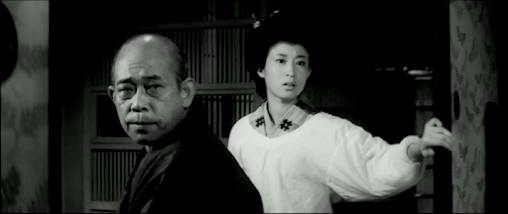Obscure Japanese Film #107

Rentaro Mikuni and Yoshiko Sakuma
In 1930s Japan, Gonsuke
(Rentaro Mikuni) is working at a sake brewery in Fushimi, Kyoto when he
receives news that his mother is seriously ill. He is given compassionate leave
to return to his village in Echigo (a former province in the snowy area of
north-central Japan now known as Niigata Prefecture). As a colleague of Gonsuke’s
named Tomekichi (Shoichi Ozawa) is from the same village, Gonsuke asks him if
he has a message for his wife, Oshin (Yoshiko Sakuma). Tomekichi asks him to
tell Oshin that he’s just been promoted. This is news to Gonsuke, who was
already jealous of Tomekichi’s marriage to such an attractive woman as Oshin
and is now doubly displeased to hear that he’s been passed over for promotion
in favour of Tomekichi.
On his way home, Gonsuke stops off at an inn, where he falls into conversation with a fellow customer (Eijro Tono) who it turns out used to be in the army with Gonsuke’s elder brother. This lascivious old man tells Gonsuke tales of the brother’s many sexual conquests while they were stationed in Russia together. Gonsuke gets drunk with him before leaving and begins to brood about his own lack of a sex life before completing his journey home. When he’s nearly reached the village, he encounters Oshin walking home alone from her job weaving tatami mats. He makes a clumsy pass at her but, finding himself rejected, he rapes her in the snow.
While Gonsuke was committing this crime, his mother was dying; when he gets home, it’s already too late. However, he seems not only indifferent to her death, but actually full of himself for having managed to have his way with Oshin when there was nobody around. After his mother’s funeral, he visits her and again makes advances but is again rejected. His vanity wounded, he decides to get revenge by telling Tomekichi that Oshin is having an affair with the foreman at her workplace (Kei Sato)…
If that partial synopsis rings a bell, that’s because this is a clever recycling of Othello – the setting and the personalities may be considerably altered, but essentially Gonsuke is Iago, Tomekichi is Othello, Oshin is Desdemona and the foreman is Cassio. Due to the way the plot unfolds, it’s clear that this is no coincidence, especially if we take into account that the film was based on a 1962 novel by Tsutomu Mizukami (or Minakami), who would certainly have been familiar with the major plays of Shakespeare. Mizukami was a fine writer whose other filmed novels include The Temple of Wild Geese, Bamboo Dolls of Echizen, Straits of Hunger (aka A Fugitive from the Past) and Lake of Tears (also starring Yoshiko Sakuma). I recommend the Dalkey Archive’s English translation of The Temple of Wild Geese and Bamboo Dolls of Echizen in one volume if you can find it.
The great thing about
this kind of story is that it could happen to people of any era or country, so
it has not dated at all and probably never will (unlike some of director
Tadashi Imai’s more topical pictures, such as Darkness at Noon, for example). Partly for this reason, A Story from Echigo may be his best
film, in my opinion (not that I’ve seen them all). Another reason is that the
performances from all three principles are outstanding. Rentaro Mikuni was
always at his best in sleazy or unsympathetic roles, and he’s in his element
here, utterly convincing as a vulgar man with zero morals or empathy, but who
is, deep down, a sad and pathetic individual. Yoshiko Sakuma is every bit as
good playing the unfortunate victim of male lust and jealousy who does her best
to stand up to Gonsuke, but is ultimately placed in an impossible position.
Sakuma has some arduous scenes in this film, and you really have to take your
hat off to her. This may well be her most impressive performance. Shoichi Ozawa
is perhaps better known for playing leading roles of a more comic type in films
like Shohei Imamura’s The Pornographers
(1966) and Yasuzo Masumura’s Chijin no ai
(A Fool’s Love, 1967). In this more serious role, his character
changes dramatically throughout the course of the film, and he portrays this metamorphosis
extremely well. Eijiro Tono and Kei Sato make the most of their brief
appearances, while the film also benefits from the presence of two wonderful
old pros, Taiji Tonoyama and Tanie Kitabayashi, as two of the village elders.
The story is strong stuff, and even contains a not-so-subtle hint of necrophilia at one point, resulting in the film receiving an ‘Adult’ classification for its original release. At the time it was made, Toei (the studio responsible) were deliberately introducing more sex into their films in an effort to entice people away from their TV sets and back into the cinemas. According to Japanese Wikipedia, it was Toei president Shigeru Okada’s idea to feature Yoshiko Sakuma in a more ‘sexy’ role than she had previously played. Toei certainly promoted A Story from Echigo as an erotic film, though it’s hard to imagine anyone being turned on by anything in it. In any case, perhaps this element explains why such a fine film was largely overlooked as far as awards go, scraping only a Mainichi Film Concours Best Screenplay award (shared with another film) for Yasutaro Yagi (1903-87, not 1906-65 as IMDb states).
Composer Sei Ikeno and Tadashi Imai’s frequent collaborator, cinematographer Shunichiro Nakao, also deserve a nod for their fine work on this great film, which has an ending that is both devastating and perfect.
Note on the title: In the Japanese title, Echigo Tsutsuishi Oyashirazu, Tsutsuishi is the name of the village the principal characters come from, while Oyashirazu refers to the Oyashirazu Cliffs in the same area.
Bonus trivia: The village scenes were shot on location at Itoigawa in Niigata Prefecture.


















